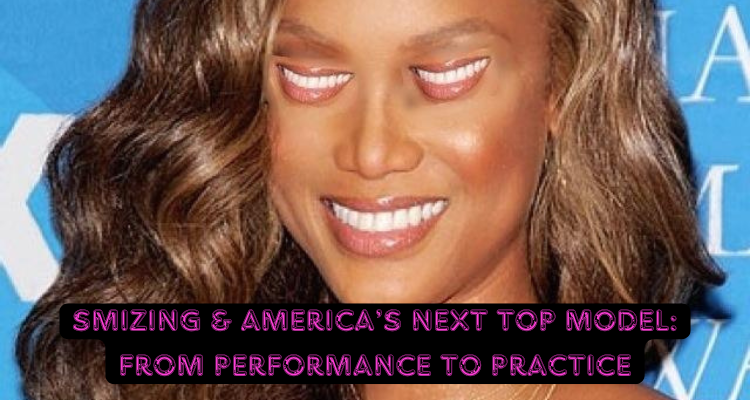Back in the golden age of reality TV, America’s Next Top Model gifted us a thousand cultural relics—but none more enduring than “smize,” Tyra Banks’ unforgettable advice to “smile with your eyes.”
What started as a cheeky modeling tip—another tool in the arsenal of high-fashion performance—has quietly evolved into something deeper. Smizing might have begun as a pose, but the ritual of it, the repetition, hints at something else: transformation.
Aesthetic Strategy or Psychological Hack?
At first, smizing feels artificial. You try it in the mirror, squinting slightly, lifting the corners of your eyes, channeling confidence you may or may not feel. It’s performance. But anyone who’s tried it knows that something weird happens if you keep doing it.
You start to feel lighter. Warmer. Maybe even a little powerful. People respond to you differently—friendlier, more open. Your expression softens, and your face becomes a site of invitation instead of defense. What changed?
The Feedback Loop of the Body
Psychologists call this the facial feedback hypothesis: the idea that expressions don’t just reflect how we feel—they shape it. A smile can trick the brain into happiness.
Smizing, as Tyra framed it, is smiling strategically—the eyes doing what the mouth can’t. And when done repeatedly, that “trick” begins to shift your baseline affect.
The performance becomes practice. The body leads the mind.
Performativity & Ritual
Here’s where we enter the real funhouse mirror: in a Žižekian or Lacanian frame, smizing is a ritual embedded in ideology.
Initially, you smize for the Other—the imagined gaze of the audience, the camera, society. You conform to a symbolic ideal: the warm, photogenic, likable person.
But through repetition, that gesture stops being fake and starts to feel real. The mask becomes the face.
The Twilight Zone Knew First
Rod Serling gave us one of the most chilling visual metaphors for this in The Twilight Zone episode “The Masks” (Season 5, Episode 25). In it, a wealthy old man on his deathbed forces his greedy relatives to wear grotesque masks during Mardi Gras—each one a hideous reflection of their true inner selves. The catch? They must wear the masks until midnight or forfeit their inheritance.
They agree, of course. And when the clock strikes twelve, the old man dies… and his family members remove their masks—only to find that their faces have physically conformed to the distortions they wore.
But beyond the horror twist, it’s a perfect allegory for the power of repeated performance. You play the role long enough, the role starts playing you. In “The Masks”, that’s a punishment. In the real world? It can go either way.
Smizing might be a friendlier mask, but the mechanism is the same. What you do habitually—what you perform for others—begins to sculpt not just how you’re seen, but who you are.
The mask becomes the face.
America’s Next Top Model as Ideological Training Ground
Reality TV thrives on transformation—physical, emotional, symbolic. ANTM was always less about modeling and more about disciplining the body into marketable visibility. Smizing wasn’t just about “looking good.” It was a micro-ritual of internalizing friendlier affect, of aligning the body with a cultural expectation of what it means to be likable, desirable, human.
But there’s something beautiful in that too. Not because it’s authentic, but because it shows how fragile the line is between the fake and the real. Between the smile we wear and the joy we feel.
Interpellation in the Hallway
The question of whether smizing is “real” or “fake” might miss the point entirely. Performance and authenticity aren’t opposites—they’re entangled. And it’s in that entanglement where something powerful happens.
I passed a woman in my apartment hallway recently. We didn’t speak. She just smiled—subtly, warmly—with her eyes. Maybe it was performative. Maybe it was genuine. I’ll never know. But it struck me.
That moment where you’re unsure if something is performed or authentic—but it hits you nonetheless—is precisely where interpellation lives. I was hailed by her smile. It called me into being, even if just for a flicker.
It doesn’t matter whether she was smiling out of habit, politeness, or genuine friendliness—because for that second, the gesture worked. It produced an encounter. A recognition. A tiny rupture.
In that collapse of performance and authenticity, something becomes possible. It’s not about what she meant; it’s about how the gesture functioned. The smile wasn’t just a sign of warmth—it produced warmth. It interpellated me into a position of openness, attention, and relation.
The Disappearance of the Smile
There’s something revealing about how smiles—once central to modeling and pop culture—have largely disappeared. Today’s dominant aesthetic is disinterested, affectless, and cool to the point of catatonia.
We’ve moved from the era of Tyra’s warmth to the hegemony of the deadpan. Not because we’ve stopped performing—but because the performance itself has shifted. Now, the dominant aesthetic is nihilistic: sleek, hollow, curated non-expression.
This detachment isn’t neutral. It’s the natural consequence of capitalism’s saturation. We no longer seek to cross symbolic thresholds or imagine new relations of production. We repeat, consume, smirk, scroll. Nothing changes.
Yet, the power of a smile hasn’t gone anywhere. If anything, it’s become rarer. More disarming. More resistant. In a culture of stylized detachment, to smile warmly—especially with your eyes—isn’t just emotional. It’s political.
Smizing isn’t outdated. It’s counter-hegemonic.
Conclusion: Smize As Praxis
So what is smizing, really?
- A modeling trick?
- A psychological hack?
- A ritual of ideological submission?
- A tool for becoming more approachable, more present, more… alive?
Yes. All of it. Smizing is camp, capitalism, psychoanalysis, and magic. It’s Tyra Banks channeling Lacan in a denim romper. It’s the gaze turned inward and reshaped through repetition. Ultimately, Tyra was right:
The revolution begins with your eyes!



